Gennaro Cuofano's Blog, page 132
December 29, 2021
Boom And Bust Cycle In A Nutshell
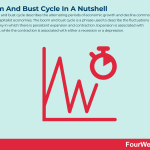

The boom and bust cycle describes the alternating periods of economic growth and decline common in many capitalist economies. The boom and bust cycle is a phrase used to describe the fluctuations in an economy in which there is persistent expansion and contraction. Expansion is associated with prosperity, while the contraction is associated with either a recession or a depression.
Understanding the boom and bust cycleBoom and bust cycles affect most areas of an economy, including sales, profits, employment rates, the housing market, government spending, and financial market performance. Since the Wall Street Crash of 1929, there have been 28 boom and bust cycles of varying intensity, frequency, and duration.
What causes boom and bust cycles?Why do boom and bust cycles occur? In other words, why does economic growth not follow a long, steady, upwards trajectory?
The answer can be found in the monetary policy of central banks. During periods of prosperity, banks lend money to individuals and businesses at low-interest rates. This money is then invested into technology, stocks, and real estate, among many other things, with investors earning higher returns as the economy grows.
When capital is easily available, individuals tend to overinvest. This practice is called malinvestment, where money is invested in a wasteful way. The abundance of capital also stimulates more demand, which creates a virtuous cycle of prosperity.
If demand outpaces supply, the economy can overheat. Too much capital chasing too few goods causes inflation, which then causes investors and businesses alike to try and outperform the market. Bad investments then pour into the market as investors ignore the obvious risks.
During the bust phase of the cycle, investor confidence plummets. Apprehensive of a stock market correction, they pour capital into assets such as gold, bonds, and the U.S. dollar. In a recession, discretionary spending decreases as consumers lose their jobs. The bust phase ends when prices are low enough to once again stimulate investor demand.
Phases of the boom and bust cycleThe boom and bust cycle has four phases, with each affording a more concise look at the machinations of alternating periods of growth and decline.
The four phases are:
Boom (expansion) – during the boom phase, economic growth accompanies a bull market with rising house prices, wage growth, and low unemployment. This phase can last for years if growth remains in a healthy range of 2-3%. However, if growth is above 4% for two or more consecutive quarters, the boom phase may be coming to an end.
End of boom (peak) – the point where expansion reaches a maximum value. The National Bureau of Economic Research defines this phase as the inflection point where an economy ceases to expand.
Bust (contraction) – as most can appreciate, the bust phase is brutal, short, and devastating. Bust phases last an average of 11 months and are characterized by an unemployment rate of 7% or higher and a devaluing of investments. If the contraction of the economy lasts more than 3 months, it is considered a recession. Any resultant stock market crash also causes a bear market which may last for years.
End of bust (trough) – the end of the bust phase is the point where the economy stops contracting and begins to expand.
Key takeaways:The boom and bust cycle describes the alternating periods of economic growth and decline common to many capitalist economies. Since the Wall Street Crash of 1929, there have been 28 boom and bust cycles.The boom and bust cycle is caused by the monetary policy of central banks, who lower interest rates and freely lend capital during periods of prosperity. Irrational and unsustainable investment behavior then causes the economy to overheat. The boom and bust cycle has four phases: boom, end of boom, bust, and end of bust. The cycle is ultimately set in motion if economic growth exceeds 4% in two or more consecutive quarters.Read Next: Tulip mania, Mississippi Bubble, South Sea Bubble, Stock Market Crash of 1929, Japanese Lost Decade, Dot-com Bubble, 2007-8 Global Financial Crisis.
Main Free Guides:
Business ModelsBusiness CompetitionBusiness StrategyBusiness DevelopmentDigital Business ModelsDistribution ChannelsMarketing StrategyPlatform Business ModelsRevenue ModelsTech Business ModelsBlockchain Business Models FrameworkConnected Business Concepts Venture Capital A venture capitalist generally invests in companies and startups which are still in a stage where their business model needs to be proved viable, or they need resources to scale up. Thus, those companies present high risks, but the potential for exponential growth. Therefore, venture capitalists look for startups that can bring a high ROI and high valuation multiples.Economic Moat
A venture capitalist generally invests in companies and startups which are still in a stage where their business model needs to be proved viable, or they need resources to scale up. Thus, those companies present high risks, but the potential for exponential growth. Therefore, venture capitalists look for startups that can bring a high ROI and high valuation multiples.Economic Moat Economic or market moats represent the long-term business defensibility. Or how long a business can retain its competitive advantage in the marketplace over the years. Warren Buffet who popularized the term “moat” referred to it as a share of mind, opposite to market share, as such it is the characteristic that all valuable brands have.Meme Investing
Economic or market moats represent the long-term business defensibility. Or how long a business can retain its competitive advantage in the marketplace over the years. Warren Buffet who popularized the term “moat” referred to it as a share of mind, opposite to market share, as such it is the characteristic that all valuable brands have.Meme Investing Meme stocks are securities that go viral online and attract the attention of the younger generation of retail investors. Meme investing, therefore, is a bottom-up, community-driven approach to investing that positions itself as the antonym to Wall Street investing. Also, meme investing often looks at attractive opportunities with lower liquidity that might be easier to overtake, thus enabling wide speculation, as “meme investors” often look for disproportionate short-term returns.Payment for Order Flow
Meme stocks are securities that go viral online and attract the attention of the younger generation of retail investors. Meme investing, therefore, is a bottom-up, community-driven approach to investing that positions itself as the antonym to Wall Street investing. Also, meme investing often looks at attractive opportunities with lower liquidity that might be easier to overtake, thus enabling wide speculation, as “meme investors” often look for disproportionate short-term returns.Payment for Order Flow Payment for order flow consists of a “kickback” or commission that the broker routing customers to a market maker (in charge of enabling the bid and ask price) will pay a commission to the broker as a sort of market-making fee.What is a SPAC
Payment for order flow consists of a “kickback” or commission that the broker routing customers to a market maker (in charge of enabling the bid and ask price) will pay a commission to the broker as a sort of market-making fee.What is a SPAC A special purpose acquisition company (SPAC) is a company with no commercial operations that are created to raise capital through an IPO to acquire another company. The SPAC is also called for that reason a “blank check company” as it will use the money provided by investors to enable private companies to go public via the SPAC.
A special purpose acquisition company (SPAC) is a company with no commercial operations that are created to raise capital through an IPO to acquire another company. The SPAC is also called for that reason a “blank check company” as it will use the money provided by investors to enable private companies to go public via the SPAC.The post Boom And Bust Cycle In A Nutshell appeared first on FourWeekMBA.
Assemble-To-Order In A Nutshell
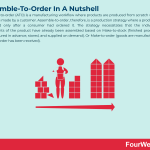

Assemble-to-order (ATO) is a manufacturing workflow where products are produced from scratch when an order is made by a customer. Assemble-to-order, therefore, is a production strategy where a product is assembled only after a consumer had ordered it. The strategy necessitates that the individual components of the product have already been assembled based on Make-to-stock (finished products manufactured in advance, stored, and supplied on demand). Or Make-to-order (goods are manufactured once the order has been received).
Understanding assemble-to-orderAssemble-to-order is a hybrid of two related strategies:
Make-to-stock (MTS)Where finished products are manufactured in advance of a customer order and then stored to match supply with demand. MTS is most commonly seen in high-volume goods and consumables.
Make-to-order (MTO)Where products are manufactured once the order has been received. With production driven by demand, the supply chain does not begin until there is sufficient interest from consumers. The MTO approach is associated with luxury goods made in very small batches.
Assemble-to-order combines the benefits of the MTS and MTO strategies into one framework. The general idea is for a business to deliver goods quickly, reduce storage costs, and retain some degree of product customization during mass production.
To do this, it must be able to assemble product components efficiently. Maintaining appropriate component inventories must also be forecasted using historical order volume, macroeconomic trends, and prevailing market conditions.
Examples of assemble-to-order companiesThere are many successful examples of assemble-to-order companies. We have listed a few of these below:
DellThe computer manufacturer keeps a physical inventory of processors, monitors, software, hardware, and other accessories. These are only assembled into a computer once a customer has ordered a highly customizable device.
Boost JuiceAn Australian franchise beverage company that sells smoothies, juices, and protein shakes. The company purchases various fruits, vegetables, and other bases and only assembles them once the customer places an order.
FerrariEvery Ferrari that rolls off the production line is unique, with the customer able to create their own paint color and select from a range of upholstery materials and wheel designs. To cope with increased demand for its bespoke vehicles, Ferrari upgraded its logistics software to increase production line efficiency without sacrificing the quality for which it is known.
Strengths and weaknesses of the assemble-to-order approachSome of the advantages of incorporating the assemble-to-order approach include:
Lower carrying costs – without the need to store finished products, carrying costs are reduced. For one, the business can invest in a smaller warehouse to save money on rent, lighting, and security. The business also saves money on transportation costs and the number of man-hours required to move inventory from one place to another.Product customization – companies such as Dell can thrive in competitive markets because they offer a high degree of product customization. Customers receive a bespoke product tailored to their individual needs, which increases brand loyalty and can drive repeated purchases.Conversely, some of the weaknesses include:
Low supply – storing individual components instead of finished products means there is more scope for inventory to run low. Seasonal demand or unexpected surges of interest in a product could result in the company running out of specific components.Longer lead times – by its very nature, assemble-to-order is associated with longer lead times because the product needs to be manufactured from scratch. Lead times can be lengthened further if the company is subject to the above inventory shortages.Key takeaways:Assemble-to-order (ATO) is a manufacturing workflow where products are produced from scratch when an order is made by a customer. Assemble-to-order is a hybrid of the make-to-stock and make-to-order strategies.Examples of assemble-to-order companies include Dell, Boost Juice, and Ferrari. Assemble-to-order results in lower carrying costs and can provide market differentiation through product customization. However, the approach can leave a business vulnerable to component shortages and longer lead times.Connected Frameworks To Assemble-To-OrderToyota Production System The Toyota Production System (TPS) is an early form of lean manufacturing created by auto-manufacturer Toyota. Created by the Toyota Motor Corporation in the 1940s and 50s, the Toyota Production System seeks to manufacture vehicles ordered by customers most quickly and efficiently possible.Lean Methodology
The Toyota Production System (TPS) is an early form of lean manufacturing created by auto-manufacturer Toyota. Created by the Toyota Motor Corporation in the 1940s and 50s, the Toyota Production System seeks to manufacture vehicles ordered by customers most quickly and efficiently possible.Lean Methodology The lean methodology is a continuous process of product development to meet customers’ needs. It was in part borrowed by the auto industry and its roots are found in the Toyota Production System, which was heavily influenced by Henry Ford’s assembly line system. The lean methodology is, therefore, an evolution from lean manufacturing, based on continuous improvement.Gemba Walk
The lean methodology is a continuous process of product development to meet customers’ needs. It was in part borrowed by the auto industry and its roots are found in the Toyota Production System, which was heavily influenced by Henry Ford’s assembly line system. The lean methodology is, therefore, an evolution from lean manufacturing, based on continuous improvement.Gemba Walk A Gemba Walk is a fundamental component of lean management. It describes the personal observation of work to learn more about it. Gemba is a Japanese word that loosely translates as “the real place”, or in business, “the place where value is created”. The Gemba Walk as a concept was created by Taiichi Ohno, the father of the Toyota Production System of lean manufacturing. Ohno wanted to encourage management executives to leave their offices and see where the real work happened. This, he hoped, would build relationships between employees with vastly different skillsets and build trust.Kaizen Approach
A Gemba Walk is a fundamental component of lean management. It describes the personal observation of work to learn more about it. Gemba is a Japanese word that loosely translates as “the real place”, or in business, “the place where value is created”. The Gemba Walk as a concept was created by Taiichi Ohno, the father of the Toyota Production System of lean manufacturing. Ohno wanted to encourage management executives to leave their offices and see where the real work happened. This, he hoped, would build relationships between employees with vastly different skillsets and build trust.Kaizen Approach Kaizen is a process developed by the auto industry. Its roots are found in the Toyota Production System, which was heavily influenced by Henry Ford’s assembly line system. The word Kaizen is a hybridization of two Japanese words, “kai” meaning “change” and “zen” meaning “good.” Two of the basic tenets of Kaizen involve making small incremental changes – or 1% improvement every day – and the full participation of everyone. Poka-yoke
Kaizen is a process developed by the auto industry. Its roots are found in the Toyota Production System, which was heavily influenced by Henry Ford’s assembly line system. The word Kaizen is a hybridization of two Japanese words, “kai” meaning “change” and “zen” meaning “good.” Two of the basic tenets of Kaizen involve making small incremental changes – or 1% improvement every day – and the full participation of everyone. Poka-yoke Poka-yoke is a Japanese quality control technique developed by former Toyota engineer Shigeo Shingo. Translated as “mistake-proofing”, poka-yoke aims to prevent defects in the manufacturing process that are the result of human error. Poka-yoke is a lean manufacturing technique that ensures that the right conditions exist before a step in the process is executed. This makes it a preventative form of quality control since errors are detected and then rectified before they occur.Value Stream Mapping
Poka-yoke is a Japanese quality control technique developed by former Toyota engineer Shigeo Shingo. Translated as “mistake-proofing”, poka-yoke aims to prevent defects in the manufacturing process that are the result of human error. Poka-yoke is a lean manufacturing technique that ensures that the right conditions exist before a step in the process is executed. This makes it a preventative form of quality control since errors are detected and then rectified before they occur.Value Stream Mapping Value stream mapping uses flowcharts to analyze and then improve on the delivery of products and services. Value stream mapping (VSM) is based on the concept of value streams – which are a series of sequential steps that explain how a product or service is delivered to consumers.Kanban Framework
Value stream mapping uses flowcharts to analyze and then improve on the delivery of products and services. Value stream mapping (VSM) is based on the concept of value streams – which are a series of sequential steps that explain how a product or service is delivered to consumers.Kanban Framework Kanban is a lean manufacturing framework first developed by Toyota in the late 1940s. The Kanban framework is a means of visualizing work as it moves through identifying potential bottlenecks. It does that through a process called just-in-time (JIT) manufacturing to optimize engineering processes, speed up manufacturing products, and improve the go-to-market strategy.Scrum
Kanban is a lean manufacturing framework first developed by Toyota in the late 1940s. The Kanban framework is a means of visualizing work as it moves through identifying potential bottlenecks. It does that through a process called just-in-time (JIT) manufacturing to optimize engineering processes, speed up manufacturing products, and improve the go-to-market strategy.Scrum Scrum is a methodology co-created by Ken Schwaber and Jeff Sutherland for effective team collaboration on complex products. Scrum was primarily thought for software development projects to deliver new software capability every 2-4 weeks. It is a sub-group of agile also used in project management to improve startups’ productivity.SMART Goals
Scrum is a methodology co-created by Ken Schwaber and Jeff Sutherland for effective team collaboration on complex products. Scrum was primarily thought for software development projects to deliver new software capability every 2-4 weeks. It is a sub-group of agile also used in project management to improve startups’ productivity.SMART Goals A SMART goal is any goal with a carefully planned, concise, and trackable objective. To be such a goal needs to be specific, measurable, achievable, relevant, and time-based. Bringing structure and trackability to goal setting increases the chances goals will be achieved, and it helps align the organization around those goals.TQM Framework
A SMART goal is any goal with a carefully planned, concise, and trackable objective. To be such a goal needs to be specific, measurable, achievable, relevant, and time-based. Bringing structure and trackability to goal setting increases the chances goals will be achieved, and it helps align the organization around those goals.TQM Framework The Total Quality Management (TQM) framework is a technique based on the premise that employees continuously work on their ability to provide value to customers. Importantly, the word “total” means that all employees are involved in the process – regardless of whether they work in development, production, or fulfillment. What companies use assemble-to-order?
The Total Quality Management (TQM) framework is a technique based on the premise that employees continuously work on their ability to provide value to customers. Importantly, the word “total” means that all employees are involved in the process – regardless of whether they work in development, production, or fulfillment. What companies use assemble-to-order? One example is Ferrari where customers can create their own paint color and select from a range of upholstery materials and wheel designs, by leveraging on an assemble-to-order manufacturing process. Another example is Dell, which keeps a physical inventory of processors, monitors, software, hardware, and other accessories, while it assembles them once the customers place the orders.
What is the advantage of assemble-to-order?Some advantages of the assemble-to-order manufacturing process are lower carrying costs (without the need to store finished products, carrying costs are reduced) and product customization (companies can improve product differentiation by enabling customers to add custom featured to the product).
{ "@context": "https://schema.org", "@type": "FAQPage", "mainEntity": [ { "@type": "Question", "name": "What companies use assemble-to-order?", "acceptedAnswer": { "@type": "Answer", "text": "<p>One example is Ferrari where customers can create their own paint color and select from a range of upholstery materials and wheel designs, by leveraging on an assemble-to-order manufacturing process. Another example is Dell, which keeps a physical inventory of processors, monitors, software, hardware, and other accessories, while it assembles them once the customers place the orders. </p>" } } , { "@type": "Question", "name": "What is the advantage of assemble-to-order?", "acceptedAnswer": { "@type": "Answer", "text": "<p>Some advantages of the assemble-to-order manufacturing process are lower carrying costs (without the need to store finished products, carrying costs are reduced) and product customization (companies can improve product differentiation by enabling customers to add custom featured to the product). </p>" } } ] }The post Assemble-To-Order In A Nutshell appeared first on FourWeekMBA.
Who Is An Angel Investor? The Top Angel Investors of Our Times
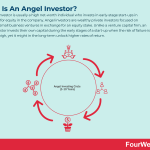

An angel investor is usually a high net-worth individual who invests in early-stage start-ups in exchange for equity in the company. Angel investors are wealthy private investors focused on financing small business ventures in exchange for an equity stake. Unlike a venture capital firm, an angel investor invests their own capital during the early stages of a start-up when the risk of failure is relatively high, yet it might in the long-term unlock higher rates of return.
Understanding angel investorsMany angel investors have excess available funds and are looking for investment opportunities delivering a higher rate of return. They tend to provide more favorable terms than other lenders because they invest in the person starting the business and not in the viability of the business itself. Indeed, the angel investor may be a close friend or family member of the entrepreneur(s).
While the angel investor does want to make a profit, this outcome is secondary to helping the start-up transition through the difficult early stages of growth. Essentially, they want to see the company survive long enough for a brilliant idea to come to fruition.
There are no formal requirements to becoming an angel investor, though many have gained accredited investor status from the Securities and Exchange Commission (SEC). These are individuals with a net worth exceeding $1 million, excluding personal residences, with an income exceeding $200k for singles or $300k for married couples.
Why do entrepreneurs prefer angel investment funding?To say that entrepreneurs require angel investment funding to keep the lights on would be too simplistic. Many often require guidance on the most optimum way to spend the money to give the business the best chance of succeeding.
Entrepreneurs prefer to work with angel investors because they:
Offer wealth and knowledgeAngel investors have previous, first-hand experience of running successful enterprises. Aside from their financial contribution, they mentor the entrepreneur to help them realize growth and higher rates of return.
Connect them with industry expertsEntrepreneurs can also gain access to the wide professional network of the angel investor. These networks provide opportunities for further mentorship, but more importantly, can also provide the basis for subsequent rounds of investment funding.
Accept inherent risksMost successful angel investments yield an internal rate of return (IRR) of 20-40% over a five to seven-year period. While angel investing is inherently risky, angel investors seek to minimize risk by evaluating the idea against predetermined criteria. These criteria may be based on industry knowledge, business model viability, the ability of the entrepreneur, and the time required to realize profit.
The most successful angel investors todayWho are the individuals at the forefront of angel investing today? We have compiled a list of five of the most prominent below:
Fabrice GrindaA French angel investor based in New York City who prefers to invest in marketplaces connecting buyers with sellers. Grinda and a panel of experts are known to analyze approximately 100 companies every week. Some of his notable investments include Flexport, Betterment, and Alibaba.
Naval RavikantAn Indian-American entrepreneur who began his angel investing journey with AngelList, a website connecting start-ups, angel investors, and job-seekers. Ravikant has invested in such companies as Uber, Opendoor, Clubhouse, Twitter, and Stack Overflow.
Paul BuchheitAn American computer engineer and entrepreneur who is best known for creating Gmail and the original prototype of Google Adsense. Buchheit is a partner in investment firm Y Combinator and manages his own angel investments in the media, information technology, health, and enterprise software industries.
Esther DysonA Swiss-born American investor, journalist, author, commentator, and philanthropist. Dyson is a leading angel investor in the space, biotechnology, government, and healthcare industries. She was an early investor in Facebook, Flickr, Space Adventures, Omada Health MeetUp, and Square.
Alexis OhanianAn Armenian-American entrepreneur, investor, activist, and author who is passionate about the open internet, STEM education, and paid family leave. Ohanian is best known for co-founding Reddit and was also a former partner of Y Combinator. Through his early-stage investment firm Initialized Capital, Ohanian manages investments worth more than $500 million in a portfolio with a market value of $36 billion.
Key takeaways:An angel investor is usually a high net-worth individual who invests in early-stage start-ups in exchange for equity in the company.In addition to investment funding, angel investors provide expert guidance on how that funding should be optimized. Entrepreneurs value angel investors for their industry knowledge, professional networks, and high-risk tolerance.Some of the notable angel investors today include Fabrice Grinda, Naval Ravikant, Paul Buchheit, Esther Dyson, and Alexis Ohanian. Connected Concepts To Angel InvestingVenture Capital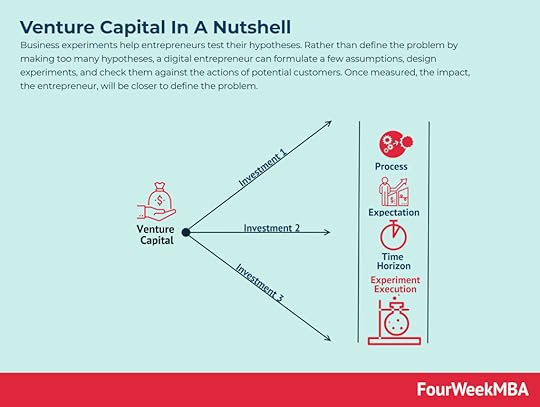 A venture capitalist generally invests in companies and startups which are still in a stage where their business model needs to be proved viable, or they need resources to scale up. Thus, those companies present high risks, but the potential for exponential growth. Therefore, venture capitalists look for startups that can bring a high ROI and high valuation multiples.Economic Moat
A venture capitalist generally invests in companies and startups which are still in a stage where their business model needs to be proved viable, or they need resources to scale up. Thus, those companies present high risks, but the potential for exponential growth. Therefore, venture capitalists look for startups that can bring a high ROI and high valuation multiples.Economic Moat Economic or market moats represent the long-term business defensibility. Or how long a business can retain its competitive advantage in the marketplace over the years. Warren Buffet who popularized the term “moat” referred to it as a share of mind, opposite to market share, as such it is the characteristic that all valuable brands have.Meme Investing
Economic or market moats represent the long-term business defensibility. Or how long a business can retain its competitive advantage in the marketplace over the years. Warren Buffet who popularized the term “moat” referred to it as a share of mind, opposite to market share, as such it is the characteristic that all valuable brands have.Meme Investing Meme stocks are securities that go viral online and attract the attention of the younger generation of retail investors. Meme investing, therefore, is a bottom-up, community-driven approach to investing that positions itself as the antonym to Wall Street investing. Also, meme investing often looks at attractive opportunities with lower liquidity that might be easier to overtake, thus enabling wide speculation, as “meme investors” often look for disproportionate short-term returns. Payment for Order Flow
Meme stocks are securities that go viral online and attract the attention of the younger generation of retail investors. Meme investing, therefore, is a bottom-up, community-driven approach to investing that positions itself as the antonym to Wall Street investing. Also, meme investing often looks at attractive opportunities with lower liquidity that might be easier to overtake, thus enabling wide speculation, as “meme investors” often look for disproportionate short-term returns. Payment for Order Flow Payment for order flow consists of a “kickback” or commission that the broker routing customers to a market maker (in charge of enabling the bid and ask price) will pay a commission to the broker as a sort of market-making fee. What is a SPAC
Payment for order flow consists of a “kickback” or commission that the broker routing customers to a market maker (in charge of enabling the bid and ask price) will pay a commission to the broker as a sort of market-making fee. What is a SPAC A special purpose acquisition company (SPAC) is a company with no commercial operations that are created to raise capital through an IPO to acquire another company. The SPAC is also called for that reason a “blank check company” as it will use the money provided by investors to enable private companies to go public via the SPAC.
A special purpose acquisition company (SPAC) is a company with no commercial operations that are created to raise capital through an IPO to acquire another company. The SPAC is also called for that reason a “blank check company” as it will use the money provided by investors to enable private companies to go public via the SPAC. The post Who Is An Angel Investor? The Top Angel Investors of Our Times appeared first on FourWeekMBA.
Aristotle Model of Communication In A Nutshell
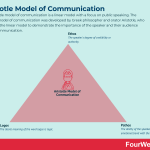

The Aristotle model of communication is a linear model with a focus on public speaking. The Aristotle model of communication was developed by Greek philosopher and orator Aristotle, who proposed the linear model to demonstrate the importance of the speaker and their audience during communication. It comprises three key elements: Ethos (the speaker’s degree of credibility or authority), Pathos (the ability of the speaker to form an emotional bond with the audience), Logos (the literal meaning of the word logos is logic).
Understanding the Aristotle model of communicationDespite its ancient origins, the Aristotle model of communication will always be relevant since public speaking is an evergreen skill that is always in demand. Public speakers today must be able to persuade or convince their audiences, something Aristotle called rhetoric.
To achieve this, the speaker organizes the speech before delivering it according to the audience and the situation at hand. This makes the Aristotle model both linear and speaker-centric, with the audience taking on a passive role in the communication process. Indeed, while the audience can be influenced by the speaker, the model does not account for the audience interacting with the speaker via feedback.
The five components of the Aristotle model of communicationThe Aristotle model of communication comprises five key components:
SpeakerThe individual tasked with persuading or convincing an audience through their speech. In theory, this is achieved through careful word selection, appropriate body language, eye contact, and verbal modulation.
SpeechThe message the speaker is delivering to the audience.
AudienceThe people who passively listen to the speech as it is delivered.
EffectThe effect may be positive or negative, depending on how persuasive the speaker may be.
OccasionOr the situation responsible for bringing people together. When a politician speaks to a group of people, the occasion may be an imminent election.
The three elements of a good public speakerGiven that the model is focused on the speaker, Aristotle also described three elements that must be present in a good communicator or orator.
They include:
EthosThe speaker’s degree of credibility or authority. A speaker with no credibility will not be trusted by the audience, no matter how moral their intentions are. Ethos can be bolstered by using appropriate language and referencing information from competent and trusted experts. It is also important to only draw logical conclusions and avoid simple errors when making an argument.
PathosThe ability of the speaker to form an emotional bond with the audience. Speakers who connect with the emotional environment of the room build trust and become more persuasive. To build pathos, the speaker can incorporate visual materials that invoke appropriate emotions. They can also begin the talk with a story demonstrating their knowledge or experience of the relevant emotional issues.
LogosThe literal meaning of the word logos is logic. In the context of Aristotle’s model, however, logos refers to the way in which facts and figures are used during communication to support particular statements. For example, a city councilor claiming crime rates rose under the previous administration must present the relevant data to verify their claims. The most skilled communicators will also examine and prepare for possible counter-arguments.
Key takeaways:The Aristotle model of communication is a linear model with a focus on public speaking. It was developed by the Greek philosopher Aristotle to produce more effective public speakers.The Aristotle model of communication is a linear and speaker-centric model with no scope for the audience to provide feedback. There are five basic components, including speaker, speech, audience, effect, and occasion.The Aristotle model of communication also details how speakers can become more persuasive. Speakers must be credible, authoritative, and be able to form an emotional connection with the audience. They must also support their statements with facts and, where necessary, engage in counter-arguments.Communicational Frameworks Connected To The Aristotle Model of Communication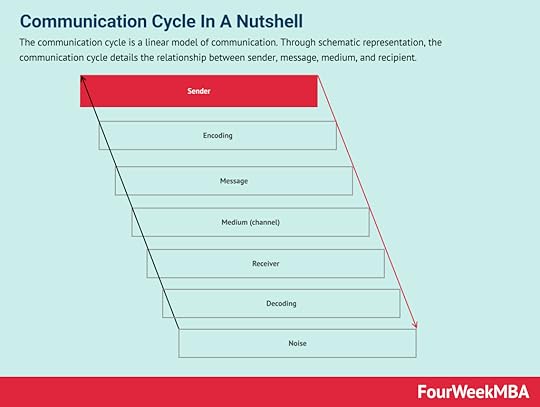 The linear model of communication is a relatively simplistic model envisaging a process in which a sender encodes and transmits a message that is received and decoded by a recipient. The linear model of communication suggests communication moves in one direction only. The sender transmits a message to the receiver, but the receiver does not transmit a response or provide feedback to the sender.
The linear model of communication is a relatively simplistic model envisaging a process in which a sender encodes and transmits a message that is received and decoded by a recipient. The linear model of communication suggests communication moves in one direction only. The sender transmits a message to the receiver, but the receiver does not transmit a response or provide feedback to the sender. Berlo’s SMCR model was created by American communication theorist David Berlo in 1960, who expanded the Shannon-Weaver model of communication into clear and distinct parts. Berlo’s SMCR model is a one-way or linear communication framework based on the Shannon-Weaver communication model.
Berlo’s SMCR model was created by American communication theorist David Berlo in 1960, who expanded the Shannon-Weaver model of communication into clear and distinct parts. Berlo’s SMCR model is a one-way or linear communication framework based on the Shannon-Weaver communication model. The Lasswell communication model is a linear framework for explaining the communication process through segmentation. Lasswell proposed media propaganda performs three social functions: surveillance, correlation, transmission. Lasswell believed the media could impact what viewers believed about the information presented.
The Lasswell communication model is a linear framework for explaining the communication process through segmentation. Lasswell proposed media propaganda performs three social functions: surveillance, correlation, transmission. Lasswell believed the media could impact what viewers believed about the information presented. The five canons of rhetoric were first organized by Roman philosopher Cicero in his treatise De Inventione in around 84 BC. Some 150 years later, Roman rhetorician Quintilian explored each of the five canons in more depth as part of his 12-volume textbook entitled Institutio Oratoria. The work helped the five canons become a major component of rhetorical education well into the medieval period. The five canons of rhetoric comprise a system for understanding powerful and effective communication.
The five canons of rhetoric were first organized by Roman philosopher Cicero in his treatise De Inventione in around 84 BC. Some 150 years later, Roman rhetorician Quintilian explored each of the five canons in more depth as part of his 12-volume textbook entitled Institutio Oratoria. The work helped the five canons become a major component of rhetorical education well into the medieval period. The five canons of rhetoric comprise a system for understanding powerful and effective communication. A communication strategy framework clarifies how businesses should communicate with their employees, investors, customers, and suppliers. Some of the key elements of an effective communication strategy move around purpose, background, objectives, target audience, messaging, and approach.
A communication strategy framework clarifies how businesses should communicate with their employees, investors, customers, and suppliers. Some of the key elements of an effective communication strategy move around purpose, background, objectives, target audience, messaging, and approach.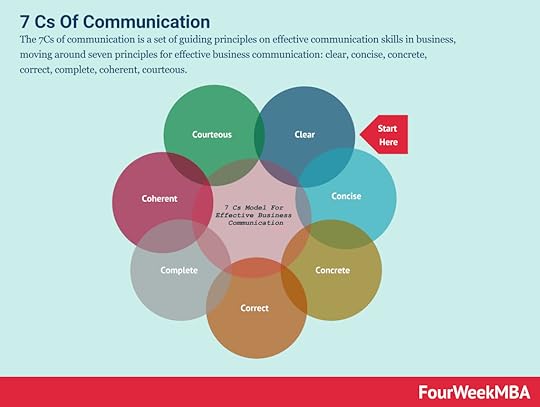 The 7Cs of communication is a set of guiding principles on effective communication skills in business, moving around seven principles for effective business communication: clear, concise, concrete, correct, complete, coherent, courteous.
The 7Cs of communication is a set of guiding principles on effective communication skills in business, moving around seven principles for effective business communication: clear, concise, concrete, correct, complete, coherent, courteous.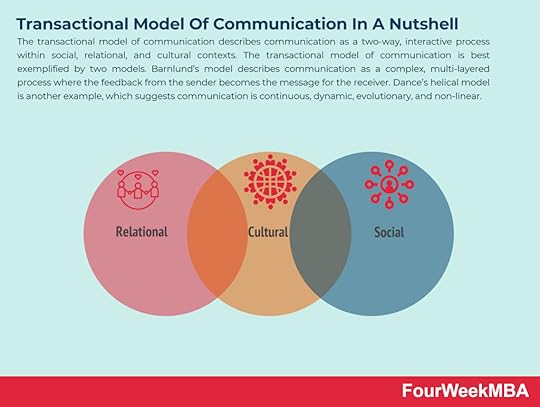 The transactional model of communication describes communication as a two-way, interactive process within social, relational, and cultural contexts. The transactional model of communication is best exemplified by two models. Barnlund’s model describes communication as a complex, multi-layered process where the feedback from the sender becomes the message for the receiver. Dance’s helical model is another example, which suggests communication is continuous, dynamic, evolutionary, and non-linear.
The transactional model of communication describes communication as a two-way, interactive process within social, relational, and cultural contexts. The transactional model of communication is best exemplified by two models. Barnlund’s model describes communication as a complex, multi-layered process where the feedback from the sender becomes the message for the receiver. Dance’s helical model is another example, which suggests communication is continuous, dynamic, evolutionary, and non-linear.Main Free Guides:
Business ModelsBusiness CompetitionBusiness StrategyBusiness DevelopmentDigital Business ModelsDistribution ChannelsMarketing StrategyPlatform Business ModelsRevenue ModelsTech Business ModelsBlockchain Business Models Framework What are the three elements present in Aristotle communication model?Given that the model is focused on the speaker, Aristotle also described three elements that must be present in a good communicator or orator: Ethos (the speaker’s degree of credibility or authority), Pathos (the ability of the speaker to form an emotional bond with the audience), Logos (the literal meaning of the word logos is logic).
What is the advantage of Aristotle's model of communication?The Aristotle model of communication is a linear model of communication that was developed by Greek philosopher and orator Aristotle, who proposed three key elements to communicate effectively: Ethos, Pathos, Logos.
{ "@context": "https://schema.org", "@type": "FAQPage", "mainEntity": [ { "@type": "Question", "name": "What are the three elements present in Aristotle communication model?", "acceptedAnswer": { "@type": "Answer", "text": "<p>Given that the model is focused on the speaker, Aristotle also described three elements that must be present in a good communicator or orator: Ethos (the speaker's degree of credibility or authority), Pathos (the ability of the speaker to form an emotional bond with the audience), Logos (the literal meaning of the word logos is logic). </p>" } } , { "@type": "Question", "name": "What is the advantage of Aristotle's model of communication?", "acceptedAnswer": { "@type": "Answer", "text": "<p>The Aristotle model of communication is a linear model of communication that was developed by Greek philosopher and orator Aristotle, who proposed three key elements to communicate effectively: Ethos, Pathos, Logos. </p>" } } ] }The post Aristotle Model of Communication In A Nutshell appeared first on FourWeekMBA.
December 28, 2021
Break-even Analysis In A Nutshell
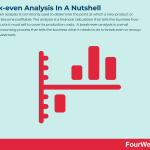

A break-even analysis is commonly used to determine the point at which a new product or service will become profitable. The analysis is a financial calculation that tells the business how many products it must sell to cover its production costs. A break-even analysis is a small business accounting process that tells the business what it needs to do to break even or recoup its initial investment.
Understanding a break-even analysisFor example, a break-even analysis may tell a business how many hours of service it needs to sell to cover its office space costs. Another business may use the analysis to determine how many cars it needs to sell to cover the cost of import tariffs.
Regardless of the context, the break-even analysis enables businesses to determine the point at which their endeavor becomes profitable. The results of the analysis may encourage the business to borrow money until the break-even point is reached. Alternatively, it may abandon the endeavor entirely.
Calculating the break-even pointThe break-even analysis involves a relatively simple calculation, with the equation as follows:
Break-even quantity = fixed costs / (sales price per unit – variable costs per unit)
Also note that:
Fixed costs are those that do not change with varying output, such as depreciation, rent, and management salaries.The sales price per unit is the price the product is sold at, andThe variable cost per unit includes the variable costs incurred during product creation. Variable costs are affected by increases or decreases in production output.Let’s break down the above equation by considering the example of a television manufacturer.
The company has fixed costs of $750,000, which include machinery depreciation and the lease on the factory.
The company also has variable costs of $100 which are derived from the purchasing of components, sales commissions, and production taxes. Each finished television sells for $1500.
Thus, the break-even point for the manufacturer is 750,000 / (1500-100) = 535.71. In other words, the company would need to sell at least 536 televisions to break even.
When should a break-even analysis be performed?The break-even analysis is useful in four common scenarios, including:
Starting a new businessThe break-even analysis is particularly important in determining whether a new business venture is economically viable. The analysis forces entrepreneurs to define realistic costs and pricing strategies.
Adding a new sales channelWhen a new sales channel is added, costs will change even if the prices do not. For example, an eCommerce shoe retailer looking to establish a new physical store will need to ensure the store breaks even. Otherwise, it may put the more profitable online store at risk. Costs may also increase if the retailer decides to sell shoes on Instagram and expenses associated with advertising and marketing must also be considered.
Creating a new productA break-even analysis should always be performed before committing to product development. Even if fixed costs remain the same, it is important to quantify the important variable costs that could make or break the initiative.
Changing business modelIf, for example, the shoe retailer wants to transition from holding physical inventory to drop shipping, a break-even analysis will determine whether prices need to change to reflect the new business model.
Key takeaways:A break-even analysis is a small business accounting process that tells the business what it needs to do to break even or recoup its initial investment. The break-even point tells the business how many products it must sell to cover its production costs. Calculating the break-even point involves accurately determining fixed costs, variable costs, and the sales price per unit. A break-even analysis is commonly used in four scenarios, including starting a new business, adding a new sales channel, creating a new product, and changing the company’s business model.Connected Frameworks To The Break-Even AnalysisFailure Mode And Effects Analysis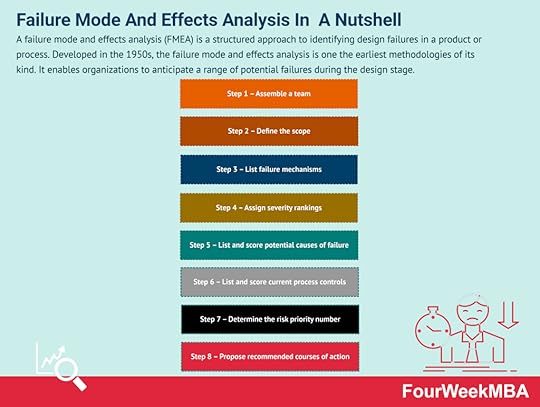 A failure mode and effects analysis (FMEA) is a structured approach to identifying design failures in a product or process. Developed in the 1950s, the failure mode and effects analysis is one the earliest methodologies of its kind. It enables organizations to anticipate a range of potential failures during the design stage.Agile Business Analysis
A failure mode and effects analysis (FMEA) is a structured approach to identifying design failures in a product or process. Developed in the 1950s, the failure mode and effects analysis is one the earliest methodologies of its kind. It enables organizations to anticipate a range of potential failures during the design stage.Agile Business Analysis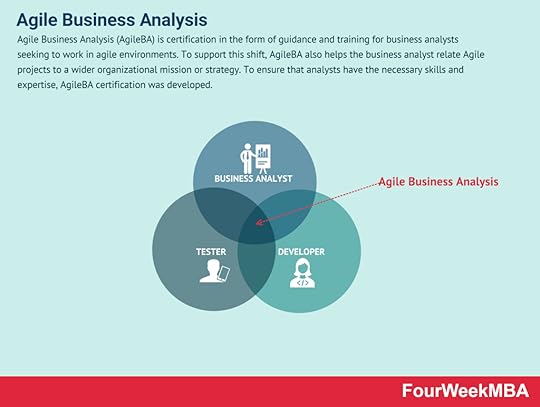 Agile Business Analysis (AgileBA) is certification in the form of guidance and training for business analysts seeking to work in agile environments. To support this shift, AgileBA also helps the business analyst relate Agile projects to a wider organizational mission or strategy. To ensure that analysts have the necessary skills and expertise, AgileBA certification was developed.Business Valuation
Agile Business Analysis (AgileBA) is certification in the form of guidance and training for business analysts seeking to work in agile environments. To support this shift, AgileBA also helps the business analyst relate Agile projects to a wider organizational mission or strategy. To ensure that analysts have the necessary skills and expertise, AgileBA certification was developed.Business Valuation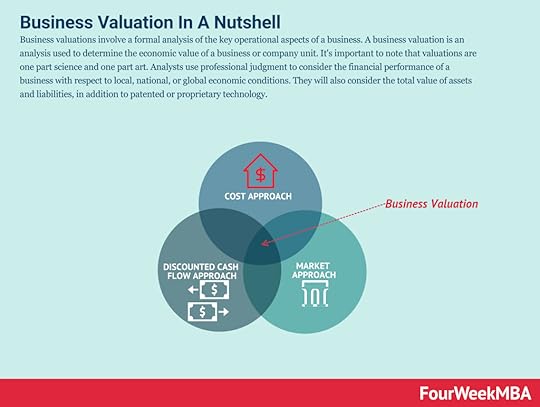 Business valuations involve a formal analysis of the key operational aspects of a business. A business valuation is an analysis used to determine the economic value of a business or company unit. It’s important to note that valuations are one part science and one part art. Analysts use professional judgment to consider the financial performance of a business with respect to local, national, or global economic conditions. They will also consider the total value of assets and liabilities, in addition to patented or proprietary technology.Paired Comparison Analysis
Business valuations involve a formal analysis of the key operational aspects of a business. A business valuation is an analysis used to determine the economic value of a business or company unit. It’s important to note that valuations are one part science and one part art. Analysts use professional judgment to consider the financial performance of a business with respect to local, national, or global economic conditions. They will also consider the total value of assets and liabilities, in addition to patented or proprietary technology.Paired Comparison Analysis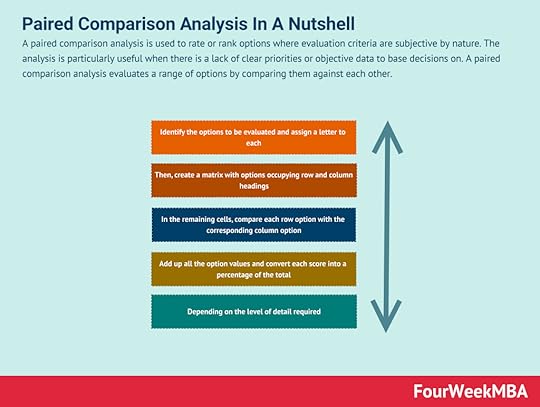 A paired comparison analysis is used to rate or rank options where evaluation criteria are subjective by nature. The analysis is particularly useful when there is a lack of clear priorities or objective data to base decisions on. A paired comparison analysis evaluates a range of options by comparing them against each other.Monte Carlo Analysis
A paired comparison analysis is used to rate or rank options where evaluation criteria are subjective by nature. The analysis is particularly useful when there is a lack of clear priorities or objective data to base decisions on. A paired comparison analysis evaluates a range of options by comparing them against each other.Monte Carlo Analysis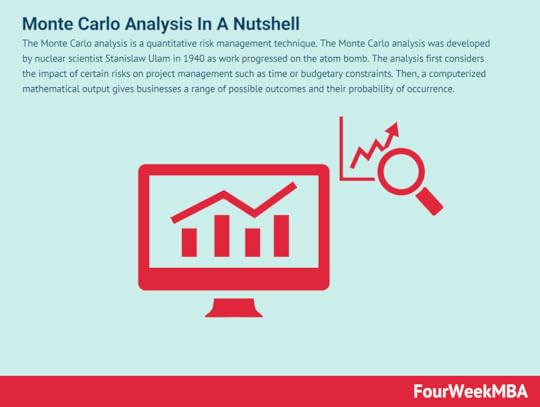 The Monte Carlo analysis is a quantitative risk management technique. The Monte Carlo analysis was developed by nuclear scientist Stanislaw Ulam in 1940 as work progressed on the atom bomb. The analysis first considers the impact of certain risks on project management such as time or budgetary constraints. Then, a computerized mathematical output gives businesses a range of possible outcomes and their probability of occurrence.Cost-Benefit Analysis
The Monte Carlo analysis is a quantitative risk management technique. The Monte Carlo analysis was developed by nuclear scientist Stanislaw Ulam in 1940 as work progressed on the atom bomb. The analysis first considers the impact of certain risks on project management such as time or budgetary constraints. Then, a computerized mathematical output gives businesses a range of possible outcomes and their probability of occurrence.Cost-Benefit Analysis A cost-benefit analysis is a process a business can use to analyze decisions according to the costs associated with making that decision. For a cost analysis to be effective it’s important to articulate the project in the simplest terms possible, identify the costs, determine the benefits of project implementation, assess the alternatives.Financial Modeling
A cost-benefit analysis is a process a business can use to analyze decisions according to the costs associated with making that decision. For a cost analysis to be effective it’s important to articulate the project in the simplest terms possible, identify the costs, determine the benefits of project implementation, assess the alternatives.Financial Modeling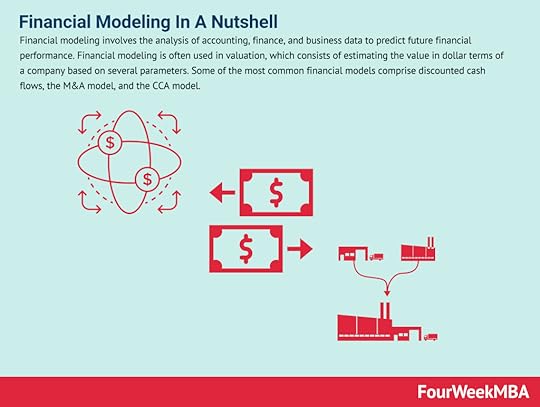 Financial modeling involves the analysis of accounting, finance, and business data to predict future financial performance. Financial modeling is often used in valuation, which consists of estimating the value in dollar terms of a company based on several parameters. Some of the most common financial models comprise discounted cash flows, the M&A model, and the CCA model.CATWOE Analysis
Financial modeling involves the analysis of accounting, finance, and business data to predict future financial performance. Financial modeling is often used in valuation, which consists of estimating the value in dollar terms of a company based on several parameters. Some of the most common financial models comprise discounted cash flows, the M&A model, and the CCA model.CATWOE Analysis The CATWOE analysis is a problem-solving strategy that asks businesses to look at an issue from six different perspectives. The CATWOE analysis is an in-depth and holistic approach to problem-solving because it enables businesses to consider all perspectives. This often forces management out of habitual ways of thinking that would otherwise hinder growth and profitability. Most importantly, the CATWOE analysis allows businesses to combine multiple perspectives into a single, unifying solution.VTDF Framework
The CATWOE analysis is a problem-solving strategy that asks businesses to look at an issue from six different perspectives. The CATWOE analysis is an in-depth and holistic approach to problem-solving because it enables businesses to consider all perspectives. This often forces management out of habitual ways of thinking that would otherwise hinder growth and profitability. Most importantly, the CATWOE analysis allows businesses to combine multiple perspectives into a single, unifying solution.VTDF Framework It’s possible to identify the key players that overlap with a company’s business model with a competitor analysis. This overlapping can be analyzed in terms of key customers, technologies, distribution, and financial models. When all those elements are analyzed, it is possible to map all the facets of competition for a tech business model to understand better where a business stands in the marketplace and its possible future developments.Pareto Analysis
It’s possible to identify the key players that overlap with a company’s business model with a competitor analysis. This overlapping can be analyzed in terms of key customers, technologies, distribution, and financial models. When all those elements are analyzed, it is possible to map all the facets of competition for a tech business model to understand better where a business stands in the marketplace and its possible future developments.Pareto Analysis The Pareto Analysis is a statistical analysis used in business decision making that identifies a certain number of input factors that have the greatest impact on income. It is based on the similarly named Pareto Principle, which states that 80% of the effect of something can be attributed to just 20% of the drivers.Comparable Analysis
The Pareto Analysis is a statistical analysis used in business decision making that identifies a certain number of input factors that have the greatest impact on income. It is based on the similarly named Pareto Principle, which states that 80% of the effect of something can be attributed to just 20% of the drivers.Comparable Analysis A comparable company analysis is a process that enables the identification of similar organizations to be used as a comparison to understand the business and financial performance of the target company. To find comparables you can look at two key profiles: the business and financial profile. From the comparable company analysis it is possible to understand the competitive landscape of the target organization.SWOT Analysis
A comparable company analysis is a process that enables the identification of similar organizations to be used as a comparison to understand the business and financial performance of the target company. To find comparables you can look at two key profiles: the business and financial profile. From the comparable company analysis it is possible to understand the competitive landscape of the target organization.SWOT Analysis A SWOT Analysis is a framework used for evaluating the business’s Strengths, Weaknesses, Opportunities, and Threats. It can aid in identifying the problematic areas of your business so that you can maximize your opportunities. It will also alert you to the challenges your organization might face in the future.PESTEL Analysis
A SWOT Analysis is a framework used for evaluating the business’s Strengths, Weaknesses, Opportunities, and Threats. It can aid in identifying the problematic areas of your business so that you can maximize your opportunities. It will also alert you to the challenges your organization might face in the future.PESTEL Analysis The PESTEL analysis is a framework that can help marketers assess whether macro-economic factors are affecting an organization. This is a critical step that helps organizations identify potential threats and weaknesses that can be used in other frameworks such as SWOT or to gain a broader and better understanding of the overall marketing environment.Business Analysis
The PESTEL analysis is a framework that can help marketers assess whether macro-economic factors are affecting an organization. This is a critical step that helps organizations identify potential threats and weaknesses that can be used in other frameworks such as SWOT or to gain a broader and better understanding of the overall marketing environment.Business Analysis Business analysis is a research discipline that helps driving change within an organization by identifying the key elements and processes that drive value. Business analysis can also be used in Identifying new business opportunities or how to take advantage of existing business opportunities to grow your business in the marketplace.
Business analysis is a research discipline that helps driving change within an organization by identifying the key elements and processes that drive value. Business analysis can also be used in Identifying new business opportunities or how to take advantage of existing business opportunities to grow your business in the marketplace.Main Free Guides:
Business ModelsBusiness StrategyBusiness DevelopmentDigital Business ModelsDistribution ChannelsMarketing StrategyPlatform Business ModelsRevenue ModelsTech Business ModelsBlockchain Business Models FrameworkThe post Break-even Analysis In A Nutshell appeared first on FourWeekMBA.
Brand Switching In A Nutshell
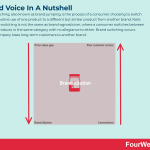

Brand switching, also known as brand jumping, is the process of a consumer choosing to switch from the routine use of one product to a different but similar product from another brand. Note that brand switching is not the same as brand-agnosticism, where a consumer switches between different products in the same category with no allegiance to either. Brand switching occurs when a company loses long-term customers to another brand.
Understanding brand switchingConvincing customers to switch brands is a difficult task, particularly in the case of loyal followers who have been purchasing the same brand for years. Nevertheless, many advertising and marketing campaigns encourage consumers to do so.
Organizations incorporate brand switching into their strategies because 33% of consumers are actively searching for new brands. What’s more, research suggests a further 61% switched brands in the last twelve months because other brands successfully attracted them.
What causes brand switching?Consumers do not tend to switch brands for fun, but there are many reasons that may explain why it occurs.
Five of the most common reasons include:
Price-value gapWhile buyers are sensitive to price, brand-loyal followers tend to be less sensitive. The important thing here is value. If a business increases its prices and the customer cannot see a tangible increase in value, they may choose another brand with a more attractive price to value ratio.
Poor customer serviceIn the context of brand switching, poor customer service means the business fails to deal with dissatisfied customers appropriately. Argumentative customer service agents or those who fail to deliver support promptly tend to cause loyal customers to do business elsewhere.
Brand fatigueCustomers who become overexposed to a particular brand may experience brand fatigue. This is especially prevalent in the retail industry where businesses constantly release products to maintain market share. Ultimately, the business needs to provide frequent and relevant product innovations because consumers are always seeking novelty.
Brand dilutionRelated to brand fatigue is brand dilution, which occurs when a business enters too many new markets and neglects its core products. Inevitably, neglected products become uncompetitive as consumers switch to brands which better suit their needs.
ConvenienceSometimes brand switching occurs because of convenience. If a supermarket discontinues the sale of a particular brand of milk, shoppers may simply purchase a different brand to avoid the hassle of having to visit another store.
How can businesses avoid brand switching?Businesses that want to avoid the negative consequences of brand switching should focus on a few key areas. They should always strive to:
Provide value – 92% of customers rank value as the primary motivation for choosing a brand. Value is driven by price, content, and engagement and can be defined in a unique value proposition (UVP). Product price increases should always be explained to avoid customers resenting the business.Improve customer retention – retaining customers is much easier than attracting them in the first instance. Customer retention increases revenue and allows the business to develop deep and long-lasting relationships with its target audience. These relationships can yield new insights which can then be incorporated into product development.Address criticism – negative customer feedback is inevitable, but it does not have to result in a customer switching brands. Complaints should be dealt with efficiently, with the customer offered a free return, discount, store credit, or some other incentive.Key takeaways:Brand switching occurs when a company loses long-term customers to another brandFive of the most common reasons for a consumer switching brands include a price-value gap, poor customer service, brand fatigue, brand dilution, and convenience. To avoid brand switching, the business should identify why a customer has decided to shop elsewhere and seek to remedy the situation to prevent reoccurrence. Providing value is most important since the majority of consumers rank value as the main motivation for choosing another brand.Read also: Brand Hierarchy, Brand Pyramid, Brand Essence, Brand Building.
Main Free Guides:
Business ModelsBusiness StrategyBusiness DevelopmentDigital Business ModelsDistribution ChannelsMarketing StrategyPlatform Business ModelsRevenue ModelsTech Business ModelsBlockchain Business Models FrameworkConnected Business ConceptsUnique Selling Proposition A unique selling proposition (USP) enables a business to differentiate itself from its competitors. Importantly, a USP enables a business to stand for something that they, in turn, become known among consumers. A strong and recognizable USP is crucial to operating successfully in competitive markets.Value Proposition
A unique selling proposition (USP) enables a business to differentiate itself from its competitors. Importantly, a USP enables a business to stand for something that they, in turn, become known among consumers. A strong and recognizable USP is crucial to operating successfully in competitive markets.Value Proposition A value proposition is about how you create value for customers. While many entrepreneurial theories draw from customers’ problems and pain points, value can also be created via demand generation, which is about enabling people to identify with your brand, thus generating demand for your products and services.Competitive Advantage
A value proposition is about how you create value for customers. While many entrepreneurial theories draw from customers’ problems and pain points, value can also be created via demand generation, which is about enabling people to identify with your brand, thus generating demand for your products and services.Competitive Advantage According to Michael Porter, a competitive advantage, in a given industry could be pursued in two key ways: low cost (cost leadership), or differentiation. A third generic strategy is focus. According to Porter a failure to do so would end up stuck in the middle scenario, where the company will not retain a long-term competitive advantage.Economic Moat
According to Michael Porter, a competitive advantage, in a given industry could be pursued in two key ways: low cost (cost leadership), or differentiation. A third generic strategy is focus. According to Porter a failure to do so would end up stuck in the middle scenario, where the company will not retain a long-term competitive advantage.Economic Moat Economic or market moats represent the long-term business defensibility. Or how long a business can retain its competitive advantage in the marketplace over the years. Warren Buffet who popularized the term “moat” referred to it as a share of mind, opposite to market share, as such it is the characteristic that all valuable brands have.Brand Promise
Economic or market moats represent the long-term business defensibility. Or how long a business can retain its competitive advantage in the marketplace over the years. Warren Buffet who popularized the term “moat” referred to it as a share of mind, opposite to market share, as such it is the characteristic that all valuable brands have.Brand Promise A brand promise is usually one or two sentences that accurately communicates what a consumer should expect when interacting with a brand. When a business creates a brand promise, it is making a declaration of assurance. Brand promises are often seen as extensions of brand positioning statements that explain why a business exists. A brand promise then tells the consumer how a product is service is better than those of a competitor.Brand Voice
A brand promise is usually one or two sentences that accurately communicates what a consumer should expect when interacting with a brand. When a business creates a brand promise, it is making a declaration of assurance. Brand promises are often seen as extensions of brand positioning statements that explain why a business exists. A brand promise then tells the consumer how a product is service is better than those of a competitor.Brand Voice The brand voice describes how a brand communicates with its target audience. The exact style of communication is based on the brand persona or the collection of personality traits and values that a brand embodies regularly, and it needs to communicate the brand’s essence to the desired target audience.Mission Statement
The brand voice describes how a brand communicates with its target audience. The exact style of communication is based on the brand persona or the collection of personality traits and values that a brand embodies regularly, and it needs to communicate the brand’s essence to the desired target audience.Mission Statement A mission statement helps an organization to define its purpose in the now and communicate it to its stakeholders. That is why a good mission statement has to be concise, clear to able to articulate what’s unique about an organization, thus building trust and rapport with an audience.
A mission statement helps an organization to define its purpose in the now and communicate it to its stakeholders. That is why a good mission statement has to be concise, clear to able to articulate what’s unique about an organization, thus building trust and rapport with an audience.The post Brand Switching In A Nutshell appeared first on FourWeekMBA.
December 26, 2021
How Does Bitcoin Mining Work?
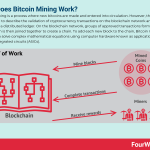

Bitcoin mining is a process where new bitcoins are made and entered into circulation. However, the term is also used to describe the validation of cryptocurrency transactions on the blockchain network and their addition to a distributed ledger. On the blockchain network, groups of approved transactions form a block which is then joined together to create a chain. To add each new block to the chain, Bitcoin miners compete to solve complex mathematical equations using computer hardware known as application-specific integrated circuits (ASICs).
The Bitcoin mining processThe most expensive of these circuits can cost up to $10,000, so it is important for miners to recoup their costs. To that end, a miner who is successful in adding a new block will receive 6.25 bitcoins as a reward – equivalent to around $300,000 using December 2021 prices. Note that the reward reduces by 50% every four years or so during events referred to as “halvings”.
To get started, the miner needs access to a digital wallet and mining software that is connected to ASIC hardware.
Why is Bitcoin mining bad for the environment?Solving complex mathematical problems requires enormous amounts of computational power. The more computational power a miner possesses, the more likely they are to solve the calculation and earn the reward.
This results in a metaphorical arms race where each miner endeavors to purchase the computer with the best hash rate, which is a metric used to measure how fast a computer can work on Bitcoin mining. These devices require more electricity to run, with a collective network of them consuming vast amounts of energy.
Though estimates vary, The New York Times claims the process of mining Bitcoin consumes around 91 terawatt-hours every year. This is more electricity than the 5.5 million citizens of Finland use over the same period.
Digital trend platform Digiconomist suggests the carbon footprint of a single Bitcoin transaction is around 978.25kg, equivalent to 2,168,135 Visa transactions or more than 163,000 hours watching YouTube. What’s more, each transaction produces 309 grams of electronic waste, comparable to the waste produced by almost two iPhone 12s.
In the United States, some energy providers are only meeting increased demand by burning fossil fuels such as coal. In fact, states with ailing coal industries such as Montana, Kentucky, and New York are seeking to profit from the crypto trend by encouraging Bitcoin mining companies to invest in operations there.
Is Bitcoin mining profitable?While the figures touted earlier suggest Bitcoin mining to be a profitable endeavor, this only tells part of the story. The process is profitable under certain circumstances, but this is impacted by the cost of electricity and mining equipment.
Miners in countries where electricity is expensive may find mining unsustainable. Conversely, miners with access to cheaper electricity often reside in third-world countries where the cost of mining equipment is prohibitive.
Profit potential is also impacted by:
Competition from other miners, which is only set to increase.Volatility in the Bitcoin price.The halving process, which reduces miner rewards by 50% every four years.Key takeaways:Bitcoin mining is a process where new bitcoins are made and entered into circulation. The process also describes the validation of cryptocurrency transactions on the blockchain network and their addition to a distributed ledger.To get started, a Bitcoin miner needs a digital wallet and mining software that is connected to sophisticated computer hardware that can solve mathematical problems. The device with superior computational power has the best chance of mining Bitcoin.Bitcoin mining is bad for the environment because it has a large carbon footprint. Annual electricity consumption is comparable to countries with populations in the tens of millions and electronic waste is also a concern. Bitcoin mining has also caused renewed interest in fossil fuel burning as suppliers seek to meet the increased demand for energy.Learn More From The Book Blockchain Business Models

Read Next: Ethereum, Blockchain Business Models Framework Decentralized Finance, Blockchain Economics, Bitcoin.
Read Also: Proof-of-stake, Proof-of-work, Blockchain, ERC-20, DAO, NFT.
Other Commercial Applications On Top Of The Blockchain Decentralized finance (DeFi) refers to an ecosystem of financial products that do not rely on traditional financial intermediaries such as banks and exchanges. Central to the success of decentralized finance is smart contracts, which are deployed on Ethereum (contracts that two parties can deploy without an intermediary). DeFi also gave rise to dApps (decentralized apps), giving developers the ability to build applications on top of the Ethereum blockchain.
Decentralized finance (DeFi) refers to an ecosystem of financial products that do not rely on traditional financial intermediaries such as banks and exchanges. Central to the success of decentralized finance is smart contracts, which are deployed on Ethereum (contracts that two parties can deploy without an intermediary). DeFi also gave rise to dApps (decentralized apps), giving developers the ability to build applications on top of the Ethereum blockchain. An ERC-20 Token stands for “Ethereum Request for Comments,” which is a standard built on top of Ethereum to enable other tokens to be issued. Based on a smart contract that determines its rules, the ERC-20 enables anyone to issue tokens on top of Ethereum. As they are using a standard, those are interoperable. ERC-20 Tokens are critical to understanding the development of Ethereum as a business platform.
An ERC-20 Token stands for “Ethereum Request for Comments,” which is a standard built on top of Ethereum to enable other tokens to be issued. Based on a smart contract that determines its rules, the ERC-20 enables anyone to issue tokens on top of Ethereum. As they are using a standard, those are interoperable. ERC-20 Tokens are critical to understanding the development of Ethereum as a business platform.Decentralized Autonomous Organizations
 A decentralized autonomous organization (DAO) operates autonomously on blockchain protocol under rules governed by smart contracts. DAO is among the most important innovations that Blockchain has brought to the business world, which can create “super entities” or large entities that do not have a central authority but are instead managed in a decentralized manner.
A decentralized autonomous organization (DAO) operates autonomously on blockchain protocol under rules governed by smart contracts. DAO is among the most important innovations that Blockchain has brought to the business world, which can create “super entities” or large entities that do not have a central authority but are instead managed in a decentralized manner. Non-fungible tokens (NFTs) are cryptographic tokens that represent something unique. Non-fungible assets are those that are not mutually interchangeable. Non-fungible tokens contain identifying information that makes them unique. Unlike Bitcoin – which has a supply of 21 million identical coins – they cannot be exchanged like for like.
Non-fungible tokens (NFTs) are cryptographic tokens that represent something unique. Non-fungible assets are those that are not mutually interchangeable. Non-fungible tokens contain identifying information that makes them unique. Unlike Bitcoin – which has a supply of 21 million identical coins – they cannot be exchanged like for like. Blockchain companies use sharding to partition databases and increase scalability, allowing them to process more transactions per second. Sharding is a key mechanism underneath the Ethereum Blockchain and one of its critical components. Indeed, sharding enables Blockchain protocols to overcome the Scalability Trilemma (as a Blockchain grows, it stays scalable, secure, and decentralized).
Blockchain companies use sharding to partition databases and increase scalability, allowing them to process more transactions per second. Sharding is a key mechanism underneath the Ethereum Blockchain and one of its critical components. Indeed, sharding enables Blockchain protocols to overcome the Scalability Trilemma (as a Blockchain grows, it stays scalable, secure, and decentralized). A Proof of Stake (PoS) is a form of consensus algorithm used to achieve agreement across a distributed network. As such it is, together with Proof of Work, among the key consensus algorithms for Blockchain protocols (like Ethereum’s Casper protocol). Proof of Stake has the advantage of the security, reduced risk of centralization, and energy efficiency.
A Proof of Stake (PoS) is a form of consensus algorithm used to achieve agreement across a distributed network. As such it is, together with Proof of Work, among the key consensus algorithms for Blockchain protocols (like Ethereum’s Casper protocol). Proof of Stake has the advantage of the security, reduced risk of centralization, and energy efficiency.Main Free Guides:
Business ModelsBusiness CompetitionBusiness StrategyBusiness DevelopmentDigital Business ModelsDistribution ChannelsMarketing StrategyPlatform Business ModelsRevenue ModelsTech Business ModelsBlockchain Business Models FrameworkThe post How Does Bitcoin Mining Work? appeared first on FourWeekMBA.
What Is Experiential Marketing? Experiential Marketing In A Nutshell
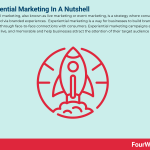

Experiential marketing, also known as live marketing or event marketing, is a strategy where consumers are engaged via branded experiences. Experiential marketing is a way for businesses to build brand awareness through face-to-face connections with consumers. Experiential marketing campaigns are immersive, live, and memorable and help businesses attract the attention of their target audience without distraction.
Understanding experiential marketingNote that these campaigns do more than just promote a product or service. Instead, they are designed to encourage customers to actively engage with the core values of a brand.
Almost 75% of consumers say that branded event marketing experiences make them more likely to buy the product being promoted. Compared to traditional marketing strategies, branded events create a much stronger impression in consumers’ minds. Experiential marketing events may take the form of trade shows, sponsorships, test drives, kiosks, contests, in-store experiences, and in-person surveys. Some of these events may cater to thousands of people, but each will come away with an experience that is unique to them.
In an age characterized by consumers craving personalized experiences and meaningful interactions before purchasing from a brand, experiential marketing is now seen as a fundamental pillar of any marketing strategy.
The three key pillars of experiential marketingTo understand experiential marketing, we must first understand the elements that constitute a great branded experience.
Such an experience should always contain the following three pillars.
1 – Active participation and engagementFirst and foremost, the consumer must be able to actively engage with a brand. Active engagement may constitute anything from taking a photo and sharing it on social media to participating in a game.
Chocolate brand Milka produced 10 million bars of chocolate with a single piece missing. The company then set up a website offering confused customers a choice: they could opt to have the missing piece of chocolate posted to them or have it sent to a friend or family member instead.
This campaign gave fans the chance to interact with the company in a meaningful way.
2 – Brand message and values promotionExperiential marketing should always be about the brand itself. The businesses must allow consumers to experience the brand – simply telling them that the brand is the best is not enough.
Budget airline Scoot set up makeshift change rooms in the middle of Melbourne, a large Australian city with a population of approximately 5 million. Pedestrians were encouraged to dress in a Grecian toga for their chance to win airline tickets to Athens.
The campaign caused much energy and enthusiasm and allowed Scoot to reinforce its fun, contemporary brand.
3 – Long-lasting valueExperiential marketing should provide long-term value to an audience. Value is facilitated through a memorable brand experience that sticks in the mind of consumers long after the event has taken place.
Athleisure brand Lululemon organizes free yoga classes in selected retail stores. This allows the company to build authentic, long-term relationships with customers by providing the sort of value it knows customers appreciate.
Key takeaways:Experiential marketing is a way for businesses to build brand awareness through face-to-face connections with consumers.Experiential marketing events may take the form of trade shows, sponsorships, test drives, kiosks, contests, in-store experiences, and in-person surveys. Some events cater to thousands of people, but each consumer walks away with a unique, personalized experience. Experiential marketing is based on the three key pillars of a branded experience: active participation and engagement, brand message and values promotion, and long-lasting value. Other Types Of Marketing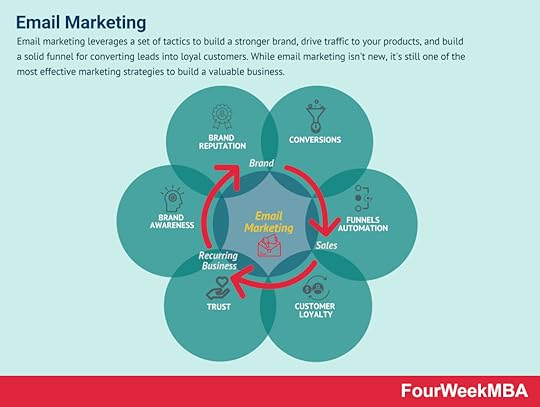 Email marketing leverages a set of tactics to build a stronger brand, drive traffic to your products, and build a solid funnel for converting leads into loyal customers. While email marketing isn’t new, it’s still one of the most effective marketing strategies to build a valuable business.
Email marketing leverages a set of tactics to build a stronger brand, drive traffic to your products, and build a solid funnel for converting leads into loyal customers. While email marketing isn’t new, it’s still one of the most effective marketing strategies to build a valuable business.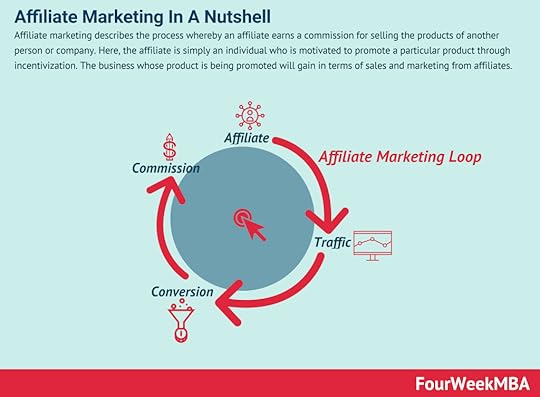 Affiliate marketing describes the process whereby an affiliate earns a commission for selling the products of another person or company. Here, the affiliate is simply an individual who is motivated to promote a particular product through incentivization. The business whose product is being promoted will gain in terms of sales and marketing from affiliates.
Affiliate marketing describes the process whereby an affiliate earns a commission for selling the products of another person or company. Here, the affiliate is simply an individual who is motivated to promote a particular product through incentivization. The business whose product is being promoted will gain in terms of sales and marketing from affiliates.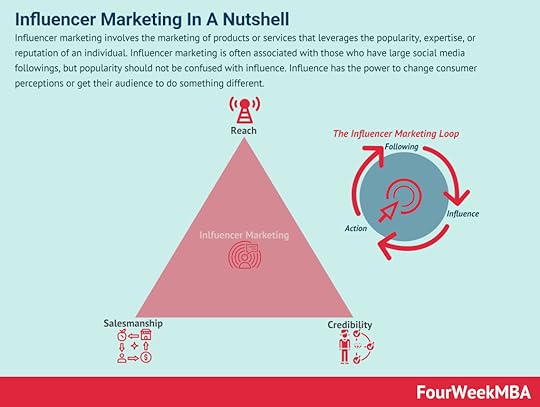 Influencer marketing involves the marketing of products or services that leverages the popularity, expertise, or reputation of an individual. Influencer marketing is often associated with those who have large social media followings, but popularity should not be confused with influence. Influence has the power to change consumer perceptions or get their audience to do something different.
Influencer marketing involves the marketing of products or services that leverages the popularity, expertise, or reputation of an individual. Influencer marketing is often associated with those who have large social media followings, but popularity should not be confused with influence. Influence has the power to change consumer perceptions or get their audience to do something different.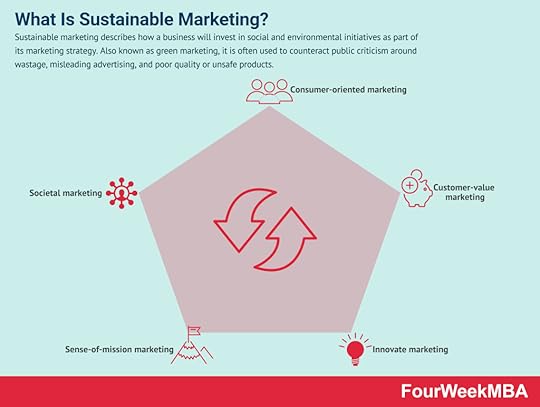 Sustainable marketing describes how a business will invest in social and environmental initiatives as part of its marketing strategy. Also known as green marketing, it is often used to counteract public criticism around wastage, misleading advertising, and poor quality or unsafe products.
Sustainable marketing describes how a business will invest in social and environmental initiatives as part of its marketing strategy. Also known as green marketing, it is often used to counteract public criticism around wastage, misleading advertising, and poor quality or unsafe products.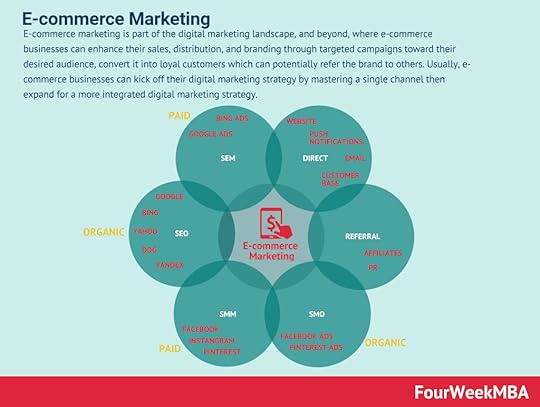 E-commerce marketing is part of the digital marketing landscape, and beyond, where e-commerce businesses can enhance their sales, distribution, and branding through targeted campaigns toward their desired audience, convert it into loyal customers which can potentially refer the brand to others. Usually, e-commerce businesses can kick off their digital marketing strategy by mastering a single channel then expand for a more integrated digital marketing strategy.
E-commerce marketing is part of the digital marketing landscape, and beyond, where e-commerce businesses can enhance their sales, distribution, and branding through targeted campaigns toward their desired audience, convert it into loyal customers which can potentially refer the brand to others. Usually, e-commerce businesses can kick off their digital marketing strategy by mastering a single channel then expand for a more integrated digital marketing strategy. Buzz marketing leverages the power of word-of-mouth advertising to create products or services with enough novelty that they go viral. In many cases, buzz marketing leverages on versatile content that can easily scale and be readapted to various contexts and fear of missing out (FOMO) to amplify the effect of word-of-mouth campaigns.
Buzz marketing leverages the power of word-of-mouth advertising to create products or services with enough novelty that they go viral. In many cases, buzz marketing leverages on versatile content that can easily scale and be readapted to various contexts and fear of missing out (FOMO) to amplify the effect of word-of-mouth campaigns.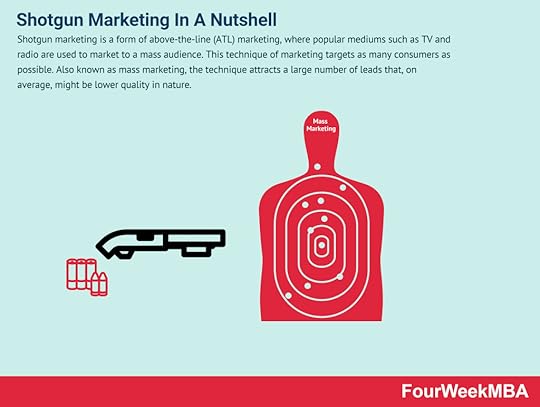 Shotgun marketing is a form of above-the-line (ATL) marketing, where popular mediums such as TV and radio are used to market to a mass audience. This technique of marketing targets as many consumers as possible. Also known as mass marketing, the technique attracts a large number of leads that, on average, might be of lower quality in nature.
Shotgun marketing is a form of above-the-line (ATL) marketing, where popular mediums such as TV and radio are used to market to a mass audience. This technique of marketing targets as many consumers as possible. Also known as mass marketing, the technique attracts a large number of leads that, on average, might be of lower quality in nature.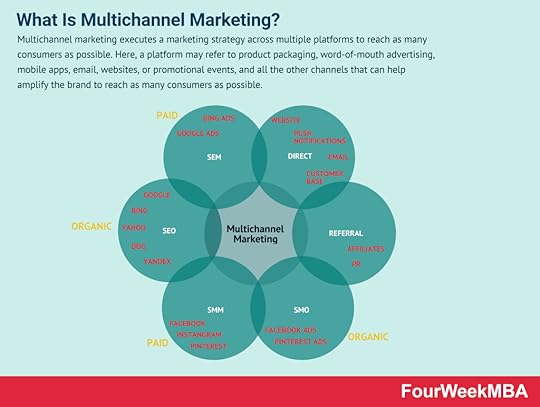 Multichannel marketing executes a marketing strategy across multiple platforms to reach as many consumers as possible. Here, a platform may refer to product packaging, word-of-mouth advertising, mobile apps, email, websites, or promotional events, and all the other channels that can help amplify the brand to reach as many consumers as possible.
Multichannel marketing executes a marketing strategy across multiple platforms to reach as many consumers as possible. Here, a platform may refer to product packaging, word-of-mouth advertising, mobile apps, email, websites, or promotional events, and all the other channels that can help amplify the brand to reach as many consumers as possible.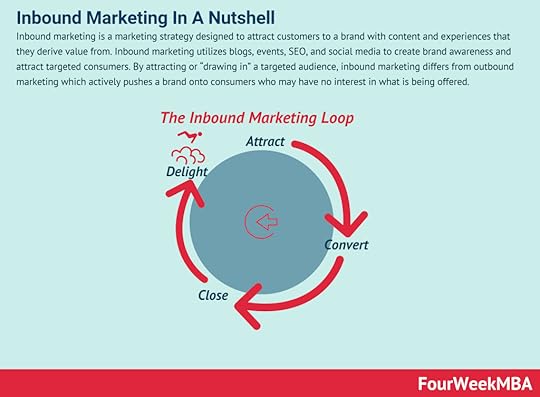 Inbound marketing is a marketing strategy designed to attract customers to a brand with content and experiences that they derive value from. Inbound marketing utilizes blogs, events, SEO, and social media to create brand awareness and attract targeted consumers. By attracting or “drawing in” a targeted audience, inbound marketing differs from outbound marketing which actively pushes a brand onto consumers who may have no interest in what is being offered.
Inbound marketing is a marketing strategy designed to attract customers to a brand with content and experiences that they derive value from. Inbound marketing utilizes blogs, events, SEO, and social media to create brand awareness and attract targeted consumers. By attracting or “drawing in” a targeted audience, inbound marketing differs from outbound marketing which actively pushes a brand onto consumers who may have no interest in what is being offered. With partnership marketing, two or more companies team up to create marketing campaigns that help them grow organically with a mutual agreement, thus making it possible to reach shared business goals. Partnership marketing leverages time and resources of partners that help them expand their market.
With partnership marketing, two or more companies team up to create marketing campaigns that help them grow organically with a mutual agreement, thus making it possible to reach shared business goals. Partnership marketing leverages time and resources of partners that help them expand their market.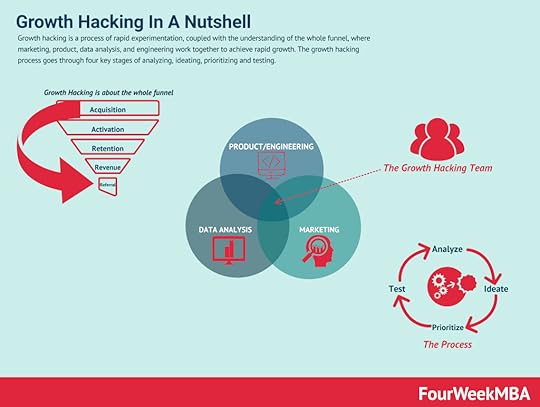 Growth marketing is a process of rapid experimentation, which in a way has to be “scientific” by keeping in mind that it is used by startups to grow, quickly. Thus, the “scientific” here is not meant in the academic sense. Growth marketing is expected to unlock growth, quickly and with an often limited budget.
Growth marketing is a process of rapid experimentation, which in a way has to be “scientific” by keeping in mind that it is used by startups to grow, quickly. Thus, the “scientific” here is not meant in the academic sense. Growth marketing is expected to unlock growth, quickly and with an often limited budget.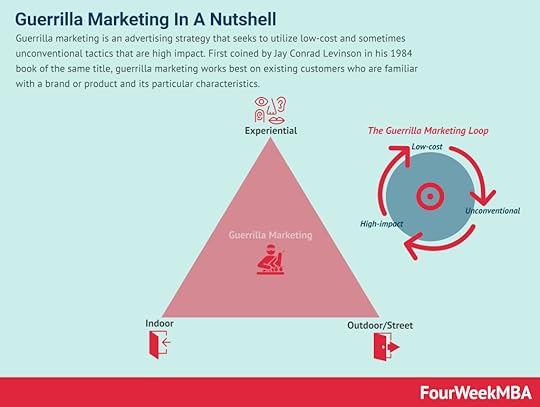 Guerrilla marketing is an advertising strategy that seeks to utilize low-cost and sometimes unconventional tactics that are high impact. First coined by Jay Conrad Levinson in his 1984 book of the same title, guerrilla marketing works best on existing customers who are familiar with a brand or product and its particular characteristics.
Guerrilla marketing is an advertising strategy that seeks to utilize low-cost and sometimes unconventional tactics that are high impact. First coined by Jay Conrad Levinson in his 1984 book of the same title, guerrilla marketing works best on existing customers who are familiar with a brand or product and its particular characteristics.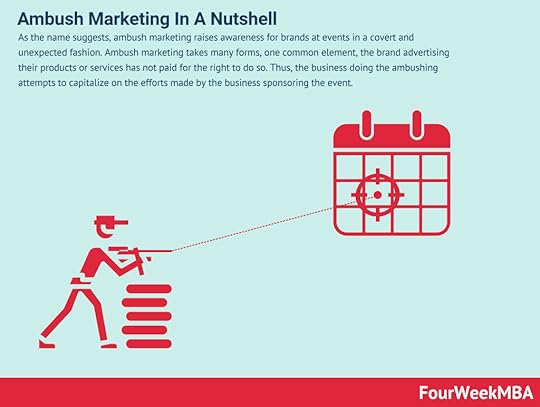 As the name suggests, ambush marketing raises awareness for brands at events in a covert and unexpected fashion. Ambush marketing takes many forms, one common element, the brand advertising their products or services has not paid for the right to do so. Thus, the business doing the ambushing attempts to capitalize on the efforts made by the business sponsoring the event.
As the name suggests, ambush marketing raises awareness for brands at events in a covert and unexpected fashion. Ambush marketing takes many forms, one common element, the brand advertising their products or services has not paid for the right to do so. Thus, the business doing the ambushing attempts to capitalize on the efforts made by the business sponsoring the event. Relationship marketing involves businesses and their brands forming long-term relationships with customers. The focus of relationship marketing is to increase customer loyalty and engagement through high-quality products and services. It differs from short-term processes focused solely on customer acquisition and individual sales.
Relationship marketing involves businesses and their brands forming long-term relationships with customers. The focus of relationship marketing is to increase customer loyalty and engagement through high-quality products and services. It differs from short-term processes focused solely on customer acquisition and individual sales.Main Free Guides:
Business ModelsBusiness CompetitionBusiness StrategyBusiness DevelopmentDigital Business ModelsDistribution ChannelsMarketing StrategyPlatform Business ModelsRevenue ModelsTech Business ModelsBlockchain Business Models FrameworkThe post What Is Experiential Marketing? Experiential Marketing In A Nutshell appeared first on FourWeekMBA.
What Is Creative Destruction? Creative Destruction In A Nutshell
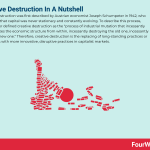

Creative destruction was first described by Austrian economist Joseph Schumpeter in 1942, who suggested that capital was never stationary and constantly evolving. To describe this process, Schumpeter defined creative destruction as the “process of industrial mutation that incessantly revolutionizes the economic structure from within, incessantly destroying the old one, incessantly creating a new one.” Therefore, creative destruction is the replacing of long-standing practices or procedures with more innovative, disruptive practices in capitalist markets.
Understanding creative destructionEssentially, the theory behind creative destruction argues that the market status quo must be destroyed to free up the resources and energy required to innovate. From Schumpeter’s point of view, economic development was driven by the opportunity to seek profit with many dynamic market forces constantly reshaped or replaced by innovation and competition. This assumption contradicted the static mathematical models of traditional economic philosophies, which saw the balancing of supply with demand as the end goal of market processes.
As the name suggests, there are winners and losers during creative destruction. A society cannot reap the rewards of growth and innovation without accepting that some individuals or businesses will suffer in the short or long term. History has shown that any attempts to reduce the negative aspects of creative destruction by preserving jobs or protecting vulnerable industries simply delays the inevitable. As a result, many consider the dichotomous nature of creative destruction to be the “paradox of progress”.
Examples of creative destructionThe evolution of the transportation industry is a classic example of creative destruction at work.
During the late 1800s and early 1900s, there were incremental improvements to horse-drawn transport which allowed it to dominate the market. When the Ford Model T was released in 1908, improvements in horse-drawn transport were quickly superseded by a more innovative form of transport which has itself undergone many improvements in the last century.
Creative destruction has also occurred in the following industries:
PhotographyWhere Kodak film cameras were replaced with digital cameras and to a lesser extent, smartphones. What is unfortunate about the Kodak story is that the company developed one of the first digital cameras but failed to capitalise on it.
MusicThe music industry has undergone many changes in the last century. Records were replaced with tapes, CDs, DVDs, mp3s, and digital music stores. Today, digital music stores have also been superseded by streaming services such as Spotify.
InternetMany industries have also suffered because of the internet, though the internet has perhaps created more industries than it has destroyed. Nevertheless, high-speed connections rendered VHS and DVD rental obsolete. Mobile internet also disrupted taxi drivers and mapmakers. Travel agents and other service providers have also suffered because of the sheer abundance of information available online.
Key takeaways:Creative destruction is the replacing of long-standing practices or procedures with more innovative, disruptive practices in capitalist markets. The term was first described by Austrian economist Joseph Schumpeter in 1942.Creative destruction is sometimes called the paradox of progress because, for industries to grow, there must necessarily be losers. Creative destruction is arguably most associated with advances in personal transportation, but it has also been seen in photography, music, travel, and entertainment.Main Free Guides:
Business ModelsBusiness CompetitionBusiness StrategyBusiness DevelopmentDigital Business ModelsDistribution ChannelsMarketing StrategyPlatform Business ModelsRevenue ModelsTech Business ModelsBlockchain Business Models FrameworkConnected Business Concepts The peer-to-peer (P2P) economy is one where buyers and sellers interact directly without the need for an intermediary third party or other business. The peer-to-peer economy is a business model where two individuals buy and sell products and services directly. In a peer-to-peer company, the seller has the ability to create the product or offer the service themselves.
The peer-to-peer (P2P) economy is one where buyers and sellers interact directly without the need for an intermediary third party or other business. The peer-to-peer economy is a business model where two individuals buy and sell products and services directly. In a peer-to-peer company, the seller has the ability to create the product or offer the service themselves. In simplistic terms, the circular flow model describes the mutually beneficial exchange of money between the two most vital parts of an economy: households, firms and how money moves between them. The circular flow model describes money as it moves through various aspects of society in a cyclical process.
In simplistic terms, the circular flow model describes the mutually beneficial exchange of money between the two most vital parts of an economy: households, firms and how money moves between them. The circular flow model describes money as it moves through various aspects of society in a cyclical process. Glocalization is a portmanteau of the words “globalization” and “localization.” It is a concept that describes a globally developed and distributed product or service that is also adjusted to be suitable for sale in the local market. With the rise of the digital economy, brands now can go global by building a local footprint.
Glocalization is a portmanteau of the words “globalization” and “localization.” It is a concept that describes a globally developed and distributed product or service that is also adjusted to be suitable for sale in the local market. With the rise of the digital economy, brands now can go global by building a local footprint. In Economics, Economies of Scale is a theory for which, as companies grow, they gain cost advantages. More precisely, companies manage to benefit from these cost advantages as they grow, due to increased efficiency in production. Thus, as companies scale and increase production, a subsequent decrease in the costs associated with it will help the organization scale further.
In Economics, Economies of Scale is a theory for which, as companies grow, they gain cost advantages. More precisely, companies manage to benefit from these cost advantages as they grow, due to increased efficiency in production. Thus, as companies scale and increase production, a subsequent decrease in the costs associated with it will help the organization scale further.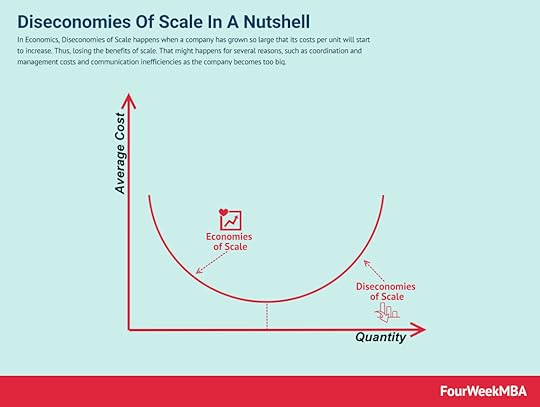 In Economics, a Diseconomy of Scale happens when a company has grown so large that its costs per unit will start to increase. Thus, losing the benefits of scale. That can happen due to several factors arising as a company scales. From coordination issues to management inefficiencies and lack of proper communication flows.
In Economics, a Diseconomy of Scale happens when a company has grown so large that its costs per unit will start to increase. Thus, losing the benefits of scale. That can happen due to several factors arising as a company scales. From coordination issues to management inefficiencies and lack of proper communication flows. In a command economy, the government controls the economy through various commands, laws, and national goals which are used to coordinate complex social and economic systems. In other words, a social or political hierarchy determines what is produced, how it is produced, and how it is distributed. Therefore, the command economy is one in which the government controls all major aspects of the economy and economic production.
In a command economy, the government controls the economy through various commands, laws, and national goals which are used to coordinate complex social and economic systems. In other words, a social or political hierarchy determines what is produced, how it is produced, and how it is distributed. Therefore, the command economy is one in which the government controls all major aspects of the economy and economic production.The post What Is Creative Destruction? Creative Destruction In A Nutshell appeared first on FourWeekMBA.
What Is The Command Economy? The Command Economy In A Nutshell
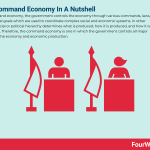

In a command economy, the government controls the economy through various commands, laws, and national goals which are used to coordinate complex social and economic systems. In other words, a social or political hierarchy determines what is produced, how it is produced, and how it is distributed. Therefore, the command economy is one in which the government controls all major aspects of the economy and economic production.
Understanding the command economyNote that private enterprise does not exist in a command economy. Instead, the government owns every company and is the sole employer. The government also controls product pricing to reconcile supply with demand and enables the state to collect revenue.
Command economies have been traditionally associated with Communist political systems where the goal is the reduction of inequality and unemployment. This approach contrasts with the free market systems associated with capitalist societies.
Command economy examplesSome current and former examples of command economies include:
ChinaFormer ruler and communist revolutionary Mao Zedong enforced a strictly planned economy in China after World War II. However, modern China employs what economists suggest is a socialist market economy, where dominant state-owned enterprises coexist with market capitalism and private ownership.
CubaThe Cuban revolution of 1959 instituted the introduction of Communism and a planned economy, with the Soviet Union subsidizing the country’s economy until 1990. Like China, Cuba is now transitioning to aspects of a free market system.
North KoreaPerhaps the country with the most centrally planned economy. However, chronic mismanagement, underinvestment, and raw material shortages have left the North Korean economy in a state of disrepair.
RussiaAfter the Russian Revolution in 1917, Vladimir Lenin created the first Communist command economy. This economy existed in some shape or form until the USSR collapsed in the late 1980s. Since then, the Kremlin has transferred ownership of large companies to oligarchs during an era of privatization.
BelarusIn this former Soviet satellite country, the government still owns more than 80% of all companies and 75% of all financial institutions.
Advantages and disadvantages of command economiesDespite the obvious drawbacks of a command economy, there do exist some distinct advantages. We have a listed a few of these below in addition to some disadvantages.
AdvantagesEfficiencyCommand economies can mobilize quickly to deploy resources on a large scale. They are not hindered by lawsuits, environmental impact statements, or anti-competitive conduct guidelines.
Less inequalityIn a free-market economy, the law of supply and demand determines where employees work and how much they are paid. In a command economy, the government reduces inequality as the sole determiner of employee job titles and salaries. The government also uses its power to create new jobs – regardless of whether there is a need for them – which reduces the unemployment rate.
DisadvantagesComplexityDespite their best efforts, many nations have found managing the complex machinations of an entire economy to be extremely difficult. Without prices to better predict supply and demand, these economies may produce too much of one good and not enough of another. Nations also become more insular because they cannot produce goods at globally competitive market prices.
Lack of innovationBusiness leaders in command economies are rewarded for following state objectives. There is no scope for innovation and the economic growth and prosperity that follows.
Key takeaways:The command economy is one in which the government controls all major aspects of the economy and economic production. Without private enterprise, the government owns every company and controls product pricing to reconcile supply with demand.Examples of current and former command economies include China, Belarus, North Korea, Russia, and Cuba. Both China and Cuba and now incorporating aspects of a free market economy into their respective systems.The command economy is more efficient at mobilizing initiatives and reducing wage inequality and unemployment. However, the difficulty in managing an economy can cause the nation to become uncompetitive, insular, and lacking in innovation.Connected Business Concepts The peer-to-peer (P2P) economy is one where buyers and sellers interact directly without the need for an intermediary third party or other business. The peer-to-peer economy is a business model where two individuals buy and sell products and services directly. In a peer-to-peer company, the seller has the ability to create the product or offer the service themselves.
The peer-to-peer (P2P) economy is one where buyers and sellers interact directly without the need for an intermediary third party or other business. The peer-to-peer economy is a business model where two individuals buy and sell products and services directly. In a peer-to-peer company, the seller has the ability to create the product or offer the service themselves. In simplistic terms, the circular flow model describes the mutually beneficial exchange of money between the two most vital parts of an economy: households, firms and how money moves between them. The circular flow model describes money as it moves through various aspects of society in a cyclical process.
In simplistic terms, the circular flow model describes the mutually beneficial exchange of money between the two most vital parts of an economy: households, firms and how money moves between them. The circular flow model describes money as it moves through various aspects of society in a cyclical process. Glocalization is a portmanteau of the words “globalization” and “localization.” It is a concept that describes a globally developed and distributed product or service that is also adjusted to be suitable for sale in the local market. With the rise of the digital economy, brands now can go global by building a local footprint.
Glocalization is a portmanteau of the words “globalization” and “localization.” It is a concept that describes a globally developed and distributed product or service that is also adjusted to be suitable for sale in the local market. With the rise of the digital economy, brands now can go global by building a local footprint. 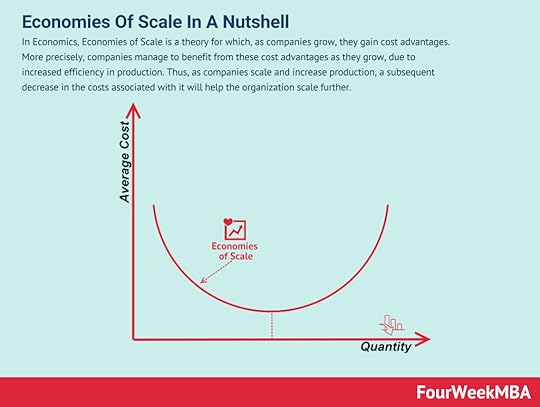 In Economics, Economies of Scale is a theory for which, as companies grow, they gain cost advantages. More precisely, companies manage to benefit from these cost advantages as they grow, due to increased efficiency in production. Thus, as companies scale and increase production, a subsequent decrease in the costs associated with it will help the organization scale further.
In Economics, Economies of Scale is a theory for which, as companies grow, they gain cost advantages. More precisely, companies manage to benefit from these cost advantages as they grow, due to increased efficiency in production. Thus, as companies scale and increase production, a subsequent decrease in the costs associated with it will help the organization scale further.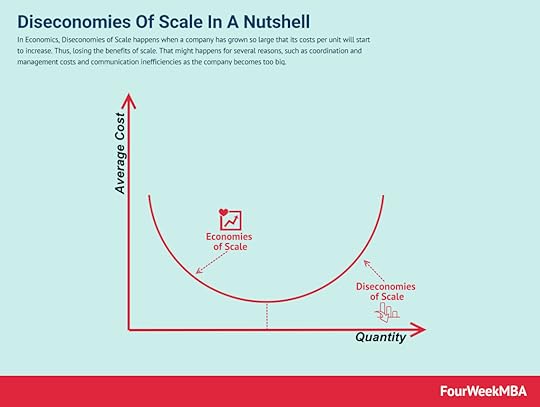 In Economics, a Diseconomy of Scale happens when a company has grown so large that its costs per unit will start to increase. Thus, losing the benefits of scale. That can happen due to several factors arising as a company scales. From coordination issues to management inefficiencies and lack of proper communication flows.
In Economics, a Diseconomy of Scale happens when a company has grown so large that its costs per unit will start to increase. Thus, losing the benefits of scale. That can happen due to several factors arising as a company scales. From coordination issues to management inefficiencies and lack of proper communication flows.Main Free Guides:
Business ModelsBusiness CompetitionBusiness StrategyBusiness DevelopmentDigital Business ModelsDistribution ChannelsMarketing StrategyPlatform Business ModelsRevenue ModelsTech Business ModelsBlockchain Business Models FrameworkThe post What Is The Command Economy? The Command Economy In A Nutshell appeared first on FourWeekMBA.



